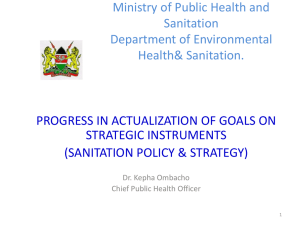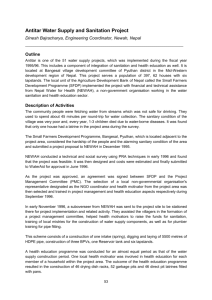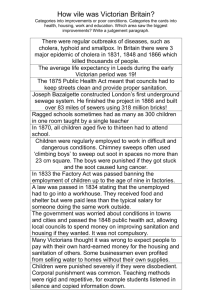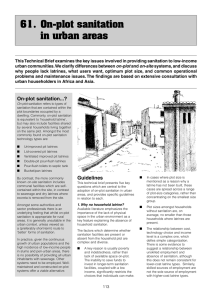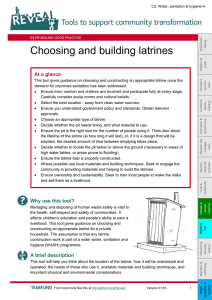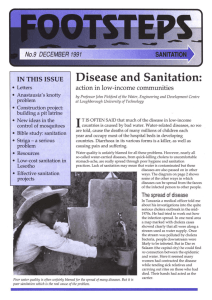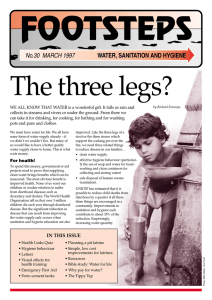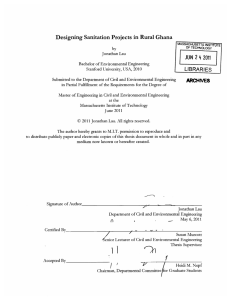ppt
advertisement
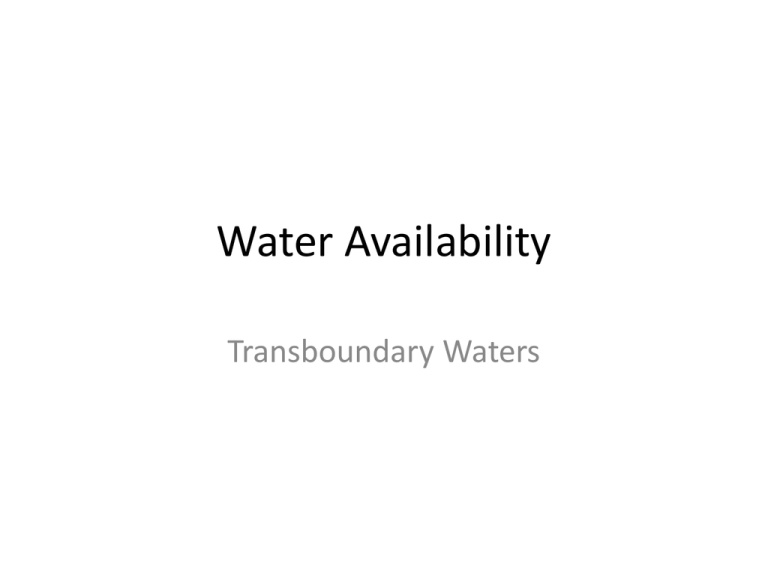
Water Availability
Transboundary Waters
Global Water Resources
Only this portion
is renewable
Total = 1,386,000,000 km3
Fresh = 35,029,000 km3 (2.5% of total)
Global Water Cycle
Principal sources
of fresh water for
human activities
44,800 km3
Global Water Availability
Population and Water Use
9000
8000
Withdrawal (km3/yr)
7000
Population (million)
6000
5000
4000
3000
2000
1000
0
global freshwater use is ~4000 km3/year
1950
1960
1970
1980
1990
2000
~10% of the renewable supply (44,800km3/year)
2010
2020
Water in ecosystems and social systems
M.Falkenmark March 09
Water in two forms
M.Falkenmark March 09
Global water budget
Precipitation
100 %
65 %
35 %
M.Falkenmark March 09
Global Water Withdrawal
Global Water Use
A basic development obstacle:
water variability
water storage per person (m3) & the
poverty trap….
in water-constrained economies
hydrologic variability
complicates food production
7 000
250
6 000
600
1980
1990
2000
-50
-200
-100
-400
-200
Cereal
yield
-600
-250
-800
Years
2 486
3 000
2 000
1 000
746
1 287
1 406
43
0
M.Falkenmark March 09
North
America
1970
Brazil
0
1960
3 255
China
0
4 000
Laos
200
50
Thailand
400
South
Africa
December
rainfall
100
4 729
5 000
Ethiopia
National rainfall index: Variation from trend (mm)
Cereal production
150
Australia
National rainfall index
Total cereal production - Variation from trend ('000 tons)
200
-150
6 150
800
Access to Water Supply
• Reasonable access to an adequate amount of safe
water
– Treated surface water and untreated but uncontaminated
water, such as from springs, sanitary wells, and protected
boreholes
– Urban areas - public fountain or standpipe located not
more than 200 meters away.
– Rural areas - members of the household do not have to
spend a disproportionate part of the day fetching water.
– An adequate amount of water is that needed to satisfy
metabolic, hygienic, and domestic requirements
Worldbank.org
Access to Sanitation
• At least adequate excreta disposal facilities
– Private or shared, but not public
– Effectively prevent human, animal, and insect contact with
excreta.
– Suitable facilities range from simple but protected pit
latrines to flush toilets with sewerage.
– To be effective, all facilities must be correctly constructed
and properly maintained.
Worldbank.org
Water Supply and Sanitation
• In 2002
– 1.1 billion people lacked access to improved water sources (17% of
the global population)
– Of those, nearly two thirds live in Asia (733 million people)
– In sub-Saharan Africa, 42% of the population is without improved
water
– 2.6 billion people lacked access to improved sanitation (42% of the
world’s population)
– Over half of those live in China and India (nearly 1.5 billion people)
– In sub-Saharan Africa, sanitation coverage is only 36%.
– In developing countries, 69% of rural dwellers lack access to improved
sanitation, as opposed 27% of urban dwellers.
Water Supply and Sanitation
• Diarrhea (WHO 2004)
– 1.8 million people die every year from diarrheal diseases
(including cholera); 90% are children under 5, mostly in
developing countries
– 88% of diarrheal disease is attributed to unsafe water
supply, inadequate sanitation and hygiene
– Improved access to water supply and sanitation can reduce
diarrhea morbidity
• Water supply: 6% – 25% (108,000 – 450,000 people)
• Sanitation: 32% (576,000 people)
• Total: 1.026 million
http://www.who.int/water_sanitation_health/diseases/burden/en/index.html
Poverty and Development
• > 1 billion people live in extreme poverty (< $1 a day)
– Sub-Saharan Africa - > 15 of every 100 children die before the age of 5
– Kenya - fertilizer costs > 2x what it costs in France or the U.S.
– Ethiopia - so deforested that rural households cannot use manure as fertilizer
because they need it as cooking fuel.
• In 2002 developed countries promised to give $210 billion
(0.7% of GNP) in ODA to end poverty
– 2005 - gave $107 billion (U.S. $28 bln)*
– 2008 – gave $120 billion (U.S. $26 bln)
– 2015 – need $195 billion
* $4.3 bln for WSS
http://www.unmillenniumproject.org/resources/fastfacts_e.htm
http://stats.oecd.org/qwids
Challenges & U.S. Response
• What’s the problem?
– Lack of capacity
– Competing interests
– Decentralization
• It’s not all about water
– It’s also about: political will, governance, and globalization
• Senator Paul Simon “Water for the Poor Act” 2005*
– Recognizes importance of water and codified the internationally
agreed goals (MDGs)
• Objectives of U.S. strategy
– Increase access to, and effective use of, safe water and sanitation
*2010 - http://www.state.gov/documents/organization/146141.pdf
*2011 - http://www.state.gov/documents/organization/166895.pdf
International River Basins
Over 40% of the world lives in a shared basin (263 of ‘em)
GEO-3: GLOBAL ENVIRONMENT OUTLOOK
http://www.unep.org/GEO/geo3/english/fig154.htm
Water Wars? Unlikely.
• Harbingers of conflict that
should be considered:
–
–
–
–
–
Unilateral development
Internationalized basin
No / ineffective institutions
General animosity
Downstream hegemony
• Some warning signs:
– Large scale development
– Rapid changes
– Civil unrest
Water in the International Arena
• We continuously read about the threat of "water wars" in the press,
where one country is likely to use military force to achieve its objectives of
water use.
• Several international groups have warned of the threat of a "water crisis"
looming in the coming century.
• Several area of the world are regularly mentioned as having tense
negotiations over shared river basins: Jordan, Ganges-Bramaputra, and
Tigres-Euphrates.
• In US, shared water resources with Canada and Mexico are now under
increased scrutiny and negotiation resulting from the environmental side
agreement to the North American Free Trade Agreement.
• In EU, multiple water “directives” are being implemented across 25
nations.
Domestic Water Use
• Survival = 5 L/day
• Drinking, cooking, bathing, and sanitation = 50 L
– United States = 250 to 300 L (Includes yard watering)
– Netherlands = 104 L
– Somalia = 9 L
– 100-600 L/c/d* (high-income)
– 50-100 L/c/d (low-income)
– 10-40 L/c/d (water scarce)
* L/c/d = liters per person per day
Water Stress Index
• Based on human consumption
– linked to population growth
• Domestic requirement:
– 100 L/c/d = 40 m3/c/yr
• Associated agricultural, industrial & energy need:
– 20 x 40 m3/c/yr = 800 m3/c/yr
• Total need:
– 840 m3/c/yr
– about 1000 m3/c/yr
Water Stress Index
• Water availability below 1,000 m3/c/yr
– chronic water related problems impeding development and harming
human health
• Water sufficiency: >1700 m3/c/yr
• Water stress: <1700 m3/c/yr
• Water scarcity: <1000 m3/c/yr
Water Supply
Improved
• Household connection
• Public standpipe
• Borehole
• Protected dug well
• Protected spring
• Rainwater collection
Not Improved
• Unprotected well
• Unprotected spring
• Vendor-provided water
• Bottled water*
• Tanker truck-provided water
World Health Organization
Sanitation
Improved
• Connection to a public
sewer
• Connection to septic system
• Pour-flush latrine
• Simple pit latrine
• Ventilated improved pit
latrine
Not Improved
• Service or bucket latrines
(where excreta are manually
removed)
• Public latrines
• Latrines with an open pit
World Health Organization
Water Stress (m3/person/year)

